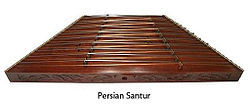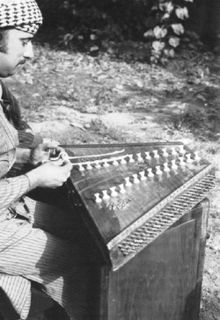Santur
 | |
| String | |
|---|---|
| Classification | Stringed, Struck |
| Playing range | |
 | |
| Related instruments | |
| Hammered dulcimer | |
| Sound sample | |
|
| |
The santur (also santūr, santour, santoor) (Persian: سنتور), is a hammered dulcimer of Iranian origins.[1][2]
History
Neo-Assyria (911-612 BCE). | |
| String instrument | |
|---|---|
| Classification | Struck |
| Related instruments | |
| Qanun | |

The santur was invented and developed in the area of Iran. "The earliest sign of it comes from Assyrian and Babylonian stone carvings (669 B.C.); it shows the instrument being played while hanging from the player's neck" (35). This instrument was traded and traveled to different parts of the Middle East. Musicians modified the original design over the centuries, yielding a wide array of musical scales and tunings. The original santur was likely made with wood and stone and strung with goat intestines. According to Habib Hasan Touma, the Babylonian santur was the ancestor of the harp, the yangqin, the harpsichord, the qanun, the cimbalom, and the hammered dulcimers.[3]
Name
The name 'santur' may come from Persian sanṭīr, a borrowing of the Greek ψαλτήριον 'psalterion'.[4] The Biblical Aramaic form psantērīn is found in the Book of Daniel 3:5.
Description
The oval-shaped mezrabs (mallets) are feather-weight and are held between the thumb, index, and middle fingers. A typical Persian santur has two sets of nine bridges, providing a range of approximately three diatonic octaves. The mezrabs are made out of wood with tips that may or may not be wrapped with cotton or felt.
The right-hand strings are made of brass or copper, while the left-hand strings are made of steel.
A total of 18 bridges divide the santur into three positions. Over each bridge cross four strings tuned in unison, spanning horizontally across the right and left side of the instrument. There are three sections of nine pitches: each for the bass, middle, and higher octave called behind the left bridges comprising 27 tones altogether. The top "F" note is repeated twice, creating a total of 25 separate tones on the santur. The Persian santur is primarily tuned to a variety of different diatonic scales utilizing 1/4 tones which are designated into 12 modes (
Derivations
Similar musical instruments have been present since medieval times all over the world, including Armenia, China, Greece, India, etc. The Indian santoor is wider, more rectangular and has more strings. Its corresponding mallets are also held differently and played with a different technique. The eastern European version of the santur called the cimbalom, which is much larger and chromatic, is used to accompany Hungarian folk music, Eastern European Jewish music, and Slavic music, as well as Romani music.[6]
Iraqi santur


The Iraqi santur (also santour, santoor ) (
It is the main instrument used in the classical
The Iraqi santur has, since its inception, been fully chromatic allowing for full maqam modulations. It uses 12 bridges of steel strings on both sides. Three of these bridges are movable: B half flat qaraar, E half flat, and B half flat jawaab. The non-standard version of the Iraqi santur includes extra bridges so that there's no need to move those three bridges. However, playing it is a bit harder than playing the standard 12-bridge santur.[3] For a video demonstration, see Wesam al-Azzawy's video links in the sections below.
Notable players
Iran
- Abol Hassan Saba
- Amir Aghasi
- Manoochehr Sadeghi
- Faramarz Payvar
- Mohammad Heydari
- Parviz Meshkatian
- Majid Kiani[7]
- Ahad Behjat
- Nasser Rastegar-Nejad
- Masoud Rezaei Nejad
- Milad Kiayie
- Mohsen Gholami
- Omid Tahmasebpour
- Mohammad Sadeq Khan[8]
- Ali Akbar Shahi[9]
- Hassan Khan[10]
- Hussein Malek[11]
- Habib Soma’i[12]
- Reza Varzandeh[13]
- Reza Shafieian[14]
- Mansur Sarami[15]
- Masoud Shaari[16]
- Siamak Aghayi
- Sourena Sefati
- Mohammad Santour Khan[17]
- Daryoush Safvat[18]
- Jalal Akhbari[19]
- Pouya Saraei
- Ardavan Kamkar
- Pejman Azarmina
- Pashang Kamkar
- Peyman Heydarian
- Kourosh Zolani
- Arfa Atrai[20]
- Azar Hashemi[21]
- Susan Aslani[22]
- Manijeh Ali Pour[23]
- Hayaf Yassine
- Masoud Malek
Iraq
Notable players of the Iraqi santur include:[24]
- Abdallah Ali (1929–1998)
- Akram Al Iraqi
- Amir ElSaffar[25]
- Azhar Kubba
- Bahir Hashem Al Rajab
- Basil al-Jarrah
- Ghazi Mahsub al-Azzawi
- Hugi Salih Rahmain Pataw (1848–1933)[26]
- Hashim Al Rajab
- Hala Bassam
- Hammudi Ali al-Wardi
- Haj Hashim Muhammad Rajab al-Ubaydi (1921–2003)
- Hendrin Hikmat (1974–)
- Heskel Shmuli Ezra (1804–1894)
- Mohamed Abbas
- Muhammad Salih al-Santurchi (18th century)
- Muhammad Zaki Darwish al-Samarra'i (1955–)[27]
- Mustafa Abd al-Qadir Tawfiq
- Qasim Muhammad Abd (1969–)
- Rahmatallah Safa'i
- Sa'ad Abd al-Latif al-Ubaydi
- Sabah Hashim
- Saif Walid al-Ubaydi
- Salman Enwiya
- Salman Sha'ul Dawud Bassun (1900–1950)
- Sha'ul Dawud Bassun (19th century)
- Shummel Salih Shmuli (1837–1915)
- Wesam al-Azzawy (1960–)[28][29][30]
- Yusuf Badros Aslan (1844–1929)
- Yusuf Hugi Pataw (1886–1976)[26]
Greece
Players of the Greek Santouri include:
- Tasos Diakogiorgis
- Aristidis Moschos
- Nikos Kalaintzis
- Marios Papadeas
- Ourania Lambropoulou
India
Notable players of the Indian santoor include:
- Ulhas Bapat (1950–2018)
- Tarun Bhattacharya (b. 1957)
- Rahul Sharma (b. 1972)
- Shivkumar Sharma (1938–2022)
- Abhay Sopori
- Bhajan Sopori (1948c2022)
- R. Visweswaran (1944–2007)
- Varsha Agrawal (b. 1967)[31]
- Mohammad Tibet Baqal (1914–1982)[32]
- Harjinder Pal Singh (b. 1953)[33]
- Sandip Chatterjee
Germany
- Bee Seavers, disciple of Shivkumar Sharma (see above)[34]
Poland
Turkey
- Santuri Ethem Bey composer of Sehnaz Longa
Lebanon
From around the world
Versions of the santur or hammered dulcimer are used throughout the world. In Eastern Europe, a larger descendant of the hammered dulcimer called the cimbalom is played and has been used by a number of classical composers, including Zoltán Kodály, Igor Stravinsky, and Pierre Boulez, and more recently, in a different musical context, by Blue Man Group. The khim is the name of both the Thai and the Khmer hammered dulcimer. The Chinese yangqin is a type of hammered dulcimer that originated in Persia. The santur and santoor are found in the Middle East and India, respectively.
|
|
|
See also
Gallery
- Santur related pictures
-
Ali Bahrami-Fard playing in Vahdat Hall
-
Chalghi santur player playing on a non-standard Iraqi santur
-
Santur hand position
-
Santur technique
References
- ]
- ^ a b --- Rashid, Subhi Anwar (1989). Al-ʼĀlāt al-musīqīyya al-muṣāhiba lil-Maqām al-ʻIrāqī. Baghdad: Matbaʻat al-ʻUmmāl al-Markazīyya.
- ^ ISBN 0-931340-88-8.
- ^ Oxford English Dictionary, updated December 2022, ''s.v.'' 'santoor'
- ISBN 052130542X.
- ISBN 978-0-8108-7561-6.
- ^ Kiani, Majid. "Master of the Santur". Santur Master, Teacher & Performer.
- ^ Khan, Mohammad Sadeq. "One of the oldest Santur Masters". Master of the Santur.
- ^ Shahi, Ali Akbar. "Santur master". Old school santur player.
- ^ Khan, Hassan. "Santur Master". Old school Santur Master.
- ^ Malek, Hussein. "Santur master". Old School Santur Master.
- ^ Somai, Habib. "santur master". Old school Santur master.
- ^ Varzandeh, Reza. "Santur Master". Unique Style of Playing.
- ^ Shafieian, Reza. "Saba's Student". Santur Master.
- ^ Sarami, Mansur. "Santur Master". Old School Santur player. Archived from the original on 2 May 2006.
- ^ Shaari, Masoud. "Santur Master". Old School Santur Master. Archived from the original on 2 May 2006.
- ^ Khan, Mohammad Santour. "Oldest Santur Master that we have proof of". Master of the Santur.
{{cite web}}: Missing or empty|url=(help) - ^ Safvat, Daryoush. "Santur Master". Old school Santur master. Archived from the original on 2 May 2006.
- ^ Akhbari, Jalal. "Old School Santur Master". Master of the Santur. Archived from the original on 2 May 2006.
- ^ Arfa, Atrai. "Santur Player". Santur Soloist.
- ^ Hashemi, Azar. "Female Santur Player". Santur Soloist. Archived from the original on 2 May 2006.
- ^ Aslani, Susan. "Female Santur Player". Santur Soloist. Archived from the original on 2 May 2006.
- ^ Ali Pour, Manijeh. "Female Santur Player". Old School Santur Player. Archived from the original on 2 May 2006.
- ^ Al-Hanafi, Jalal (1964). Al-Mughannūn al-Baghdādīyyūn wa al-Maqām al-ʻIrāqī. Baghdad: Wizarat al-Irshad.
- ^ "Amir ElSaffar | Jazz Trumpeter | Composer | Iraqi Maqam Singer | Santoor Player". Amirelsaffar.com. Retrieved 20 April 2021.
- ^ a b "Traditional Iraqi Music". Dangoor.com. Retrieved 20 April 2021.
- ^ "mohamedzakidarwish - santourmzdarwish". Sites.google.com. Retrieved 20 April 2021.
- ^ "وسام ايوب العزاوي عزف على الة السنطور". YouTube. Retrieved 20 April 2021.
- ^ "عزف على السنطور || للفنان وسام ايوب". YouTube. Retrieved 20 April 2021.
- ^ "عزف سنطور _ وسام العزاوي _مقام نهاوند". YouTube. Retrieved 20 April 2021.
- ^ "Our wishes to India's single female Santoor player Dr. Varsha Agrawal (born 29 Jan 1967)". 28 January 2013.
- ^ Shade, Chinar (14 April 2015). "CHINAR SHADE : USTAAD MUHAMMAD ABDULLAH TIBETBAQAL ( 1914-1982) SUFIANA MUSICIAN FROM KASHMIR".
- ^ "Artist - Harjinder Pal Singh (Santoor), Gharana - None". www.swarganga.org.
- ^ "Pt. Shivkumar Sharma". Shantiniketan.eu. Retrieved 20 April 2021.
Bibliography
- Al-Hanafi, Jalal (1964). Al-Mughannūn al-Baghdādīyyūn wa al-Maqām al-ʻIrāqī. Baghdad: Wizarat al-Irshad.
- ISBN 0-931340-88-8.
- Children's Book of Music' ISBN 978-0-7566-6734-4
Further reading
- Duchesne-Guillemin, Marcelle (1980). "Sur la restitution de la musique hourrite". Revue de Musicologie 66, no. 1 (1980): 5–26.
- Duchesne-Guillemin, Marcelle (1984). A Hurrian Musical Score from Ugarit: The Discovery of Mesopotamian Music, Sources from the Ancient Near East, vol. 2, fasc. 2. Malibu, CA: Undena Publications. ISBN 0-89003-158-4
- Fink, Robert (1981). The Origin of Music: A Theory of the Universal Development of Music. Saskatoon: Greenwich-Meridian.
- Gütterbock, Hans (1970). "Musical Notation in Ugarit". Revue d'assyriologie et d'archéologie orientale 64, no. 1 (1970): 45–52.
- Heydarian, P.; J.D. Reiss (2005). "The Persian music and the santur instrument" (PDF). Proceedings of Sixth International Conference on Music Information Retrieval, London, UK. Vol. 11. pp. 524–527.
- Kilmer, Anne Draffkorn (1971). The Discovery of an Ancient Mesopotamian Theory of Music. Proceedings of the American Philosophical Society 115:131–49.
- Kilmer, Anne Draffkorn (1974). "The Cult Song with Music from Ancient Ugarit: Another Interpretation". Revue d'Assyriologie 68:69–82.
- Kilmer, Anne Draffkorn (1997). "Musik, A: philologisch". Reallexikon der Assyriologie und vorderasiatischen Archäologie 8, edited by Dietz Otto Edzard, 463–82. Berlin: De Gruyter. ISBN 3-11-014809-9.
- Kilmer, Anne (2001). "Mesopotamia §8(ii)". The New Grove Dictionary of Music and Musicians, second edition, edited by John Tyrrell. London: Macmillan Publishers.
- Kilmer, Anne Draffkorn, Richard L. Crocker, and Robert R. Brown (1976). Sounds from Silence: Recent Discoveries in Ancient Near Eastern Music. Berkeley: Bit Enki Publications, 1976. Includes LP record, Bit Enki Records BTNK 101, reissued [s.d.] as CD.
- Vitale, Raoul (1982). "La Musique suméro-accadienne: gamme et notation musicale". Ugarit-Forschungen 14 (1982): 241–63.
- Wellesz, Egon, ed. (1957). New Oxford History of Music Volume I: Ancient and Oriental Music. Oxford: Oxford University Press.
- West, M[artin]. L[itchfiel]. (1994). "The Babylonian Musical Notation and the Hurrian Melodic Texts". Music and Letters 75, no. 2 (May): 161–79.
- Wulstan, David (1968). "The Tuning of the Babylonian Harp". Iraq 30:215–28.
- Wulstan, David (1971). "The Earliest Musical Notation". Music and Letters 52 (1971): 365–82.
External links
- Santur – The Art of Persian Music
- The Persian music and the santur instrument
- Santur introduction in American Lutherie magazine
- Nay-Nava Encyclopedia entry on the santur
- Dr. Ümit Mutlu's information on the santur (in Turkish)
- Santur history (in Turkish) Archived 13 February 2010 at the Wayback Machine
- The Iraqi Santur



